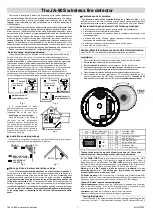
Section 3: Operating Instructions
7/30/20
RC4614 & RCM4614 Rotary Cutters 331-937M
35
Tractor & Cutter Inspection
Make the following inspections with cutter attached to a
tractor and cutter parked on a level surface, power take-
off disengaged, and cutter blades stopped.
1. Inspect tractor safety equipment to make sure it is in
good working condition.
2. Inspect cutter safety equipment to make sure it is
installed and in good working condition.
3. Check driveline to make certain it is securely
connected to the tractor and cutter. Also, make
certain that the guards are in good working condition
and in place.
4. Remove 3-point lower arms or secure them in the
raised position so they do not interfere with driveline,
hoses, or hitch.
5. Check all hoses and wires to be sure that they will not
pinch or come in contact with the folding wing and
rotating drivelines.
6. Start tractor and carefully raise and lower implement
to ensure tractor drawbar, tires, and other equipment
on the tractor do not contact cutter or driveline.
7.
Raise center deck fully up.
8. Without lowering cutter, shut tractor down properly
before dismounting. Refer to
9. Place sturdy support blocks or jack stands under the
four center deck corners.
10. Start tractor and lower center deck down onto the
supports.
11. Shut tractor down properly before dismounting. Refer
to
12. With cutter resting on solid supports, power take-off
disengaged, and blade rotation completely stopped:
•
Check for and remove foreign objects wrapped
around blade spindles.
•
Check for nicked, bent, broken, and worn cutting
blades. Replace or sharpen blades as required.
Refer to
13. Inspect hydraulic hoses for wear, damage and
hydraulic leaks. See
“Avoid High Pressure Fluids
Hazard”
on page 3. Replace damaged and worn
hoses with genuine Land Pride parts.
14. Make repairs to cutter and tractor.
15. Continue with
Blade Operation Inspection
DANGER
!
To avoid serious injury or death:
Tractor power take-off shaft shield, driveline shields, and
gearbox shaft shields must be installed and in good working
condition to avoid driveline entanglement and projectiles
WARNING
!
To avoid serious injury or death:
•
Stop power take-off immediately if vibration continues after
a few revolutions during start-up and anytime vibration
•
Do not use implement to lift objects; to pull objects such as
fence posts, stumps, etc; or to push objects. The unit is not
designed or guarded for these uses.
•
Some tractors are equipped with two power take-off speeds.
Be certain your tractor’s power take-off is set-up to operate
at the implement’s rated power take-off speed or equipment
breakage may result. RC models are rated for 540 rpm and
RCM models are rated for 1000 rpm.
1. Make sure cutter blades are not locked against each
other. See
2. Remove support blocks or jack stands and set
transport locks for field operations. See
3. Lower wing and center decks until skid shoes are
about 2" off the ground.
4. Start tractor and set throttle speed just above idle.
Use tractor’s power take-off soft start option if
available. Slowly engage power take-off to get blades
instructions on
page 38.)
5. Initial start-up vibration is normal and should stop
after a few revolutions. Stop power take-off rotation
immediately if vibration continues.
6. Once cutter is running smoothly, increase throttle to
full power take-off speed. If cutter vibrates
excessively for 3 seconds at full speed, immediately
disengage power take-off, shut tractor down properly,
and remove switch key.
7.
Block center deck up before working under cutter.
8. Check blades for a locked-up situation. Unlock
blades if locked-up.
9. Check for other probable causes such as broken or
bent blades, loose blades, loose gearbox mounting
bolts, and bent driveline.
10. Taking proper precautions, make necessary repairs
and adjustments.
11. Repeat steps 1 to 10 above to make certain vibration
problems are fixed before putting cutter back into
service.
IMPORTANT:
Read all
starting on page 33 before operating the cutter.
















































